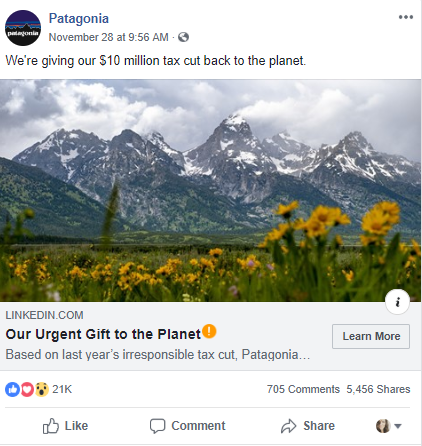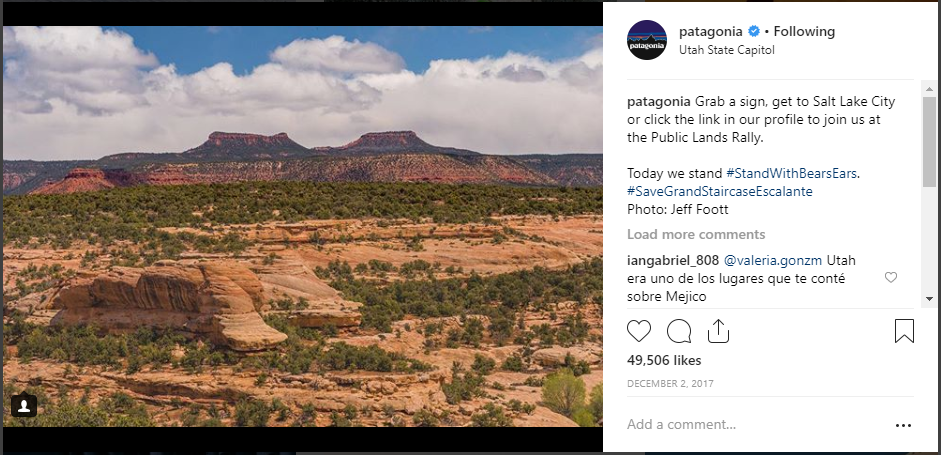Patagonia made headlines this week announcing that it will distribute all of their Trump Tax savings, approximately $10 million dollars, to conservation and environmentally focused groups (Roston, 2018). Corporate Social Responsibility (CSR) is a common practice among businesses and often associated with organizations who donate a portion of their profits or provide volunteers to local initiatives. Patagonia takes this concept of CSR one step further by aligning its mission and company values with integrating social responsibility into its entire business (Patagonia, 2018).
Why is this important? Well, Forbes reports that 63% of American consumers report wanting to see businesses take a leadership role in social and environmental changes (Elsey, 2018). In addition, 87% would consider buying a product or service based on social advocacy of a brand (Elsey, 2018). Likewise, 76% of American consumers would decline to support a company if the views supported by a brand didn’t align with their own personal belief system (Elsey, 2018). In addition, the same report suggests that the next generation of employees are looking for a triple bottom line of “people, planet, and revenue (Elsey, 2018).”
There are a few things that Patagonia can teach us about CSR and the marketing of a brand’s value system that promotes growth in profits and in loyalty.
-
Double-down on the company mission and values
Patagonia knows itself and understands that walking the walk is more powerful than just talking the talk. Donations to environmental groups have been the company’s CSR practice since 1973, now boasting a total of $185 million donated to environmental and conservation groups, since it was founded (Zurn, 2018). The company dedicates pages on its website to outline its activism, sustainability mission, and vision, as well as how it incorporates corporate partnerships, activism with its employees, and its support of environmental change campaigns (Patagonia, 2018).
In building this transparency, the brand gains trust over time. That trust has turned out to be quite profitable, with the company achieving nearly $1 billion in annual revenue for 2017 (Bhasind & Mosendz, 2017). Patagonia has learned how to re-invest where it matters and will donate large sums of money from Black Friday sales or tax savings into grassroots networks dedicated to an aligned mission of conservation (Beer, 2018).
-
Grow in alignment to the brand values
The present CEO, Rose Marcario moved the company into a new expansion of sustainably in 2008 by revising their supply chain methods and encouraging response from production to point of purchase (Beer, 2018). New growth in the brand is always aligned with considerations of transparency, sustainability, and reduction of the company’s carbon footprint (Zurn, 2017).
A new initiative focuses on recycled wear knowns as Worn Wear, which is referred to by Patagonia as a new frontier in re-commerce (Beers, 2018). Customers are encouraged to trade in old gear, in return for a gift certificate, which the company will repair or repurpose and sell as “used”(Beers, 2018). The alignment to reusing and recycling is not only authentic to the brand, but it also brings in a new customer base with its affordability. These “entry pieces” are helping to grow their brand by opening the door to younger and more cost-effective shoppers.
-
Aligning marketing channels for outreach and transparency
The social media marketing strategy doubles down on aligning to the brand’s commitment to climate change and conservation work by sharing images of their supply chain as well as their social advocacy and activism through various social media channels (Zurn, 2017). Transparency is provided through sharing each location of production mills, a breakdown of all their expenditures related to CSR, as well as a summary of their Environmental and Social Initiative Report (Zurn, 2017). Their Instagram and Facebook page not only promote a product, but they are key in sharing initiatives like Worn Wear and their activism, like #savetheblueheart, #midtermsmatter, and the infamous #protectbearsears, with their consumers.
In summary, CSR is becoming more than just a give-back opportunity or a tax-incentive for businesses. CSR is the new wave of customer engagement through advocacy and/or activism. This kind of outreach is accomplished through revealing authenticity, sharing mission and vision in social media posts, and creating new growth initiatives that connect back to the brand identity. Patagonia’s corporate social resistance has certainly elevated its popularity but it has also cemented credibility for its existing and future consumer base.
References:
Beer, J. (2018, March 15). How Patagonia Grows Every Time It Amplifies Its Social Mission. Retrieved from https://www.fastcompany.com/40525452/how-patagonia-grows-every-time-it-amplifies-its-social-mission
Bhasin, K., & Mosendz, P. (2017, December 8). Patagonia and the Big Business of Fighting Trump. Retrieved from https://www.bloomberg.com/news/articles/2017-12-08/patagonia-and-the-big-business-of-fighting-trump
Elsey, W. (2018, May 30). Why Your Company Should Be More Socially Responsible. Retrieved from https://www.forbes.com/sites/forbesbusinessdevelopmentcouncil/2018/05/30/why-your-company-should-be-more-socially-responsible/#6488e63d2c32
Patagonia. (2018). The Activist Company. Retrieved from https://www.patagonia.com/corporate-responsibility.html
Roston, E. (2018, November 28). Patagonia Donates $10 Million Trump Tax Savings to Green Groups. Retrieved from https://www.bloomberg.com/news/articles/2018-11-28/patagonia-donates-10-million-trump-tax-savings-to-green-groups
Zurn, L. (2017, May 17). How Patagonia Became a Pioneer of Corporate Social Responsibility. Retrieved from https://www.chuckjoe.co/patagonia-corporate-social-responsibility/



7 Responses to Corporate Social Resistance : What we can learn from Patagonia about authentic alignment